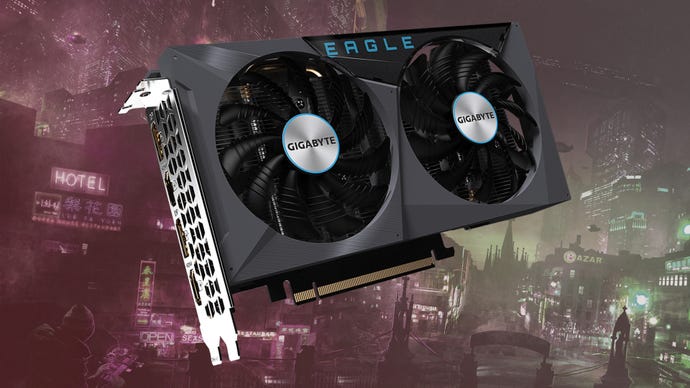The Nvidia RTX 3050 is a solid new entry-level ray tracing and DLSS GPU – if you can get it at the right price
It's a weird time for GPUs, but the Nvidia RTX 3050 is a beacon of good-quality craft... if you can find one.
It’s a weird, difficult time to review GPUs. The PC graphics market has been in overdrive for the last couple of years for several reasons. For one, people have been locked down, stuck indoors with disposable income unused – so where better to spend it than on a PC upgrade? But then there’s the stupid side of things – all this crypto mining BS – plus the impacts of the pandemic on the supply chain and production. As such, nothing about the graphics card market is reliable.
So sitting here, tasked with reviewing the cheapest RTX card from Nvidia to date, I’m faced with difficult decisions. A major factor in GPU assessment is the price-to-performance ratio, but what can you do when buying these cards at RRP is nigh impossible? The answer, really, is boring: we just have to warn you that the conclusions drawn in this review are based on the RRP, and you might find yourself more disappointed if you shell out extra to get one fast.
The Nvidia GeForce RTX 3050 punches in at £239 / $249, though you can unfortunately expect to pay a little extra in the current market. This isn’t technically all-new silicon, as the 3050 made its debut in laptops last year - but now it’s launching in a desktop format, which has been tweaked and upgraded from what was available on mobile appropriately.
Let’s just lay out where this card stands. At the top end, Nvidia has cards like the RTX 3080 and 3080 Ti, show-stopping beasts that come with a four-figure price tag to match. Before now, the entry point of the market was the RTX 3060, which we demonstrated with Minecraft and described as ‘1080p cards with a 1440p upside’, where perhaps the main reason you were buying the card was to get those RT cores which enable features like ray tracing and DLSS. Nvidia has gingerly positioned the 3050 a small clip below that card; lopping $80 off the price in exchange for taking away much of that 1440p upside.
That’s a 25% reduction in price compared to the 3060, then, and it’s fair to say that more or less everything about the card tracks in that sort of zone. From power consumption to number of cores, bandwidth, and ultimately performance, this card is around a quarter to a third less powerful than the 3060. So the price lines up - and that, at least, is good.
If you’re not rocking a 4K display, much as with the 3060, this new card can offer significant benefits without breaking the bank. A game like Assassin’s Creed Valhalla can run on medium settings at 1080p and get a near-sold 60fps without issue. The same is true for Cyberpunk 2077. Other less taxing or better optimized games can do even better; so this is a card that can deliver even better, pushing out well in excess of 60fps in relatively recent games like Hitman 3 or Resident Evil Village.

If you want to push things to 1440p, you’ll get decent performance, and certainly be able to manage a locked thirty even in more challenging modern games around medium settings - but I do think this is most at home as a 1080p card.
It’s good stuff, though much of this performance is similar to what you’d get out of a much older card such as a GTX 1660 Super. What you come to this card for, then, is that RTX designation - and the added goodies you get as a result.
To that end, let’s come back to Cyberpunk, a game that’s significantly transformed by the ray tracing presentation. If you flip on ray tracing for both reflections and shadows, the RTX 3050 essentially presents the game at 1080p medium with its frame rate halved, down to right around 30fps. It should be able to manage a relatively locked 30. Turn on DLSS, however, and you can enjoy the same quality image (more or less) with a frame rate that’s in the fifties - though sadly not quite 60fps.
DLSS, which super-samples the game image and uses AI to upscale it to avoid any artifacting, is key to making ray tracing viable on a card such as this. It can also just straight-up be used to boost performance - so if fancy lighting doesn’t bother you, knock ray tracing off and DLSS on to see Cyberpunk post close to the 100fps mark. Which, on a $250 card, really ain’t bad.
Compared to a card like the GTX 1660 Super, one of the older generation cards this aims to be a viable upgrade to, the question therefore becomes simple: do you want features like DLSS and ray tracing? If you do, and more games are constantly adding support for them, then you need those RTX cores - and this is now the cheapest option to get them. However, this card also doesn’t feel as much an upgrade as some of its 30 series siblings. The higher-end cards offered eye-popping increases on the 20 series, the previous generation - but the RTX 3050 struggles to outpace the RTX 2060 in many, many scenarios. That’s a bit of a bummer.
One place where Nvidia doesn’t struggle so much with this card is in the battle with AMD. They’ll be pleased with the results there. AMD’s closest option to this is the RX 6500 XT, which is a cheaper card but also posts some truly woeful performance; GamersNexus has a great breakdown of how it even loses to GPUs released as far back as six years ago. That card is an embarrassment even at its RRP; Nvidia’s offering has performance that feels reasonably in line with its pricing.
And so it all becomes a question of price. The RTX 3050 is meant to cost $250, but with the market dictating it’ll likely be selling for possibly as much as double that, how worthwhile it is it? Well, even a second-hand GTX 1660 Super, the card we previously referenced as a comparison point, is typically going for $500 right now. And in line with that, even $500 for this sort of lines up as acceptable - it’s the same price as an open-box last-gen card, but you get those RTX cores. If you get extremely lucky and find one in stock, non-scalped, at RRP, it’s a contextual steal.
But, wow, doesn’t this whole thing show how deeply broken the GPU market is right now? We’re talking about how $500 might not be a bad deal, market context considered, for an entry level card. It’s messed up. This can’t be fixed soon enough - and when it is, the 3050 will present as an absolute steal at $250. For now, we can recommend it - but through gritted teeth, thanks to these stupid market conditions.



